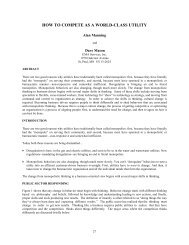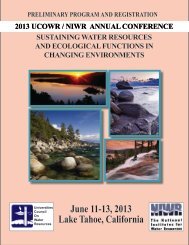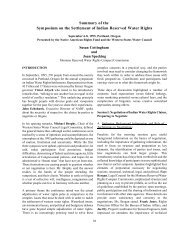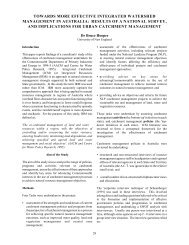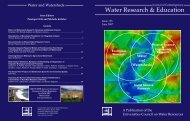122McKayState Implementation <strong>of</strong> the NWI throughRegional OrganizationsRegional delivery <strong>of</strong> natural resourcesmanagement is the principle mode <strong>of</strong> investmentunder the Natural Heritage Trust <strong>and</strong> National ActionPlan for salinity <strong>and</strong> the particular role <strong>of</strong> DEHthrough its leadership <strong>of</strong> the Natural Heritage Trustsecond Phase. Each State needs to create new regionalNatural Resources Management structures.Such bodies should include l<strong>and</strong>owners, industries,non-government organizations, indigenousrepresentatives, representatives from the three levels<strong>of</strong> government (local, state, <strong>and</strong> national) <strong>and</strong>other interested people. This is the way for local<strong>and</strong> other parties to be involved in natural resourcesmanagement (Australian Local GovernmentAssociation 2005). Australia has been divided into60 regions with each one responsible for preparinga regional natural resources management plan.The structure <strong>and</strong> nomenclature varies between<strong>and</strong> within the states based on variations in statelegislation (Mutton pers. com. 2006 SA). Theselection processes for members <strong>of</strong> the regionalbodies differ as well. The final aspect <strong>of</strong> differenceis where the state overarching body is placed inthe existing state natural resources managementprocesses. The case study from South Australiasets out the process in a well advanced state. Therole <strong>of</strong> the Natural Resources Management Councilin South Australia under the Natural ResourcesManagement Act 2004 is to draft a State Plan fornatural resources management <strong>and</strong> to take responsibilityto deliver the National Action Plan <strong>and</strong>Natural Heritage Trust bilateral Agreements signedwith the Federal Government. The State Plan is for5 years <strong>and</strong> was completed in 2005 with a 50-yearvision. The Plan informs government agencies,the eight regional Natural Resources ManagementBoards, local government, community <strong>and</strong> industrypartners (Eyre Peninsula Coastal DevelopmentStrategy 2006). Each Regional Natural ResourcesManagement Board drafts their own Regional Planinvolving all <strong>of</strong> the above with support from StateAgencies. Each Regional Plan highlights all thenatural resources management issues in the region,develops actions to address these concerns <strong>and</strong> thenselects the most important issues for action. Theplans also set resource conditions <strong>and</strong> managementaction targets based on agreed national st<strong>and</strong>ardsto help determine progress toward achieving outcomes.State-Based Definitions <strong>of</strong> EnvironmentallySustainable Development <strong>and</strong> NaturalResources Management: PotentialPartnership Problems for <strong>Water</strong> SupplyBusinessesWhile the overarching goals are set federally, themeans to achieve them are left to the states who,as in all federations, chose to do things differently.This can create a laboratory <strong>of</strong> policy experimentsthat <strong>of</strong>fer learning opportunities, but can also createconfusion (Br<strong>and</strong>ies 1932). What does sustainabledevelopment really mean? Sustainable developmentas a concept is notable for the lack <strong>of</strong> consistencyin its interpretation (Sharachch<strong>and</strong>ra 1991). Whileits breadth is appealing on the political level, thisis also its weakness as the problems <strong>of</strong> poverty,environmental degradation, economic growth, <strong>and</strong>participation are not well articulated. Such a lack<strong>of</strong> clarity may hamper the debate <strong>and</strong> certainly theimplementation.In Australia, each state has definedEnvironmentally Sustainable Development ina number <strong>of</strong> acts that apply to all actions <strong>of</strong> thewater supply businesses <strong>and</strong> other institutions.The definitions <strong>of</strong> each <strong>of</strong> these spans over manysections <strong>of</strong> each <strong>of</strong> the Acts <strong>and</strong> the rules <strong>and</strong>interpretation <strong>of</strong> Acts in each state are alsodifferent. The modern concept <strong>of</strong> EnvironmentallySustainable Development, which in someinstances date from only 1987 (Brundtl<strong>and</strong> 1987),differs in its width within each state (Table 1).The fundamental premise <strong>of</strong> EnvironmentallySustainable Development (ESD) is that economicdevelopment must be balanced against theprotection <strong>of</strong> biological diversity, the promotion<strong>of</strong> equity within <strong>and</strong> between generations, <strong>and</strong> themaintenance <strong>of</strong> essential ecological processes. TheCommonwealth Government working groups onESD drafted these principles as a guide in 1992(Hamilton <strong>and</strong> Throsby 1998) to facilitate decisionmakingprocesses to effectively integrate both long<strong>and</strong> short-term economic, environmental, social,<strong>and</strong> equity considerations.1. Lack <strong>of</strong> full scientific certainty should notbe used as a reason for postponing measuresto prevent environmental degradation (theUCOWRJOURNAL OF CONTEMPORARY WATER RESEARCH & EDUCATION
Implementation <strong>of</strong> Australian <strong>Water</strong> Laws123Table 1. Relative ranking <strong>of</strong> width <strong>of</strong> ESD definitionin four Australian states <strong>and</strong> through MBDC templatelegislation in each state 1 .Rank <strong>of</strong> ESD definitions widthMDBC Template*1 (Equal)SA (downstream) 10% in MDB area 1 (Equal)Qid (up stream) 25% in MDB area 2MSW (up stream) 90% in MDBC area 3VIC (midstream) 60% in MDb area 4*legislation inserted into state law <strong>of</strong> Queensl<strong>and</strong>,New South Wales, Vic, SAPrecautionary Principle).2. The global dimension <strong>of</strong> environmentalimpacts <strong>of</strong> actions should be recognized<strong>and</strong> considered.3. The need to develop a strong, growing<strong>and</strong> diversified economy that can enhancethe capacity for environmental protectionshould be recognized.4. The need to enhance <strong>and</strong> maintain internationalcompetitiveness in an environmentally soundmanner should be recognized.5. Decision-making processes should effectivelyintegrate both long <strong>and</strong> short-termeconomic, environmental, social, <strong>and</strong> equityconsiderations.6. Cost-effective <strong>and</strong> flexible policy instrumentsshould be adopted.7. Broad community involvement should befacilitated.This statement has been accepted by CoAG <strong>and</strong>reflects that economic efficiency is not the maingoal <strong>of</strong> water institutions but rather that there isa need to achieve ESD <strong>and</strong> balance between thesocial, economic, <strong>and</strong> environmental needs. Theseprinciples have accordingly guided the collectivethinking <strong>of</strong> governments in the formulation <strong>of</strong>contemporary water policy. Integration is required,especially under Paradigm 4, but is mentioned in anad hoc way by all the states. The CEOs were askedquestions about their perceptions <strong>of</strong> the integration<strong>of</strong> the policy processes in water reform <strong>and</strong> some<strong>of</strong> these results are reported here.CEOs <strong>of</strong> <strong>Water</strong> Supply Businesses as KeyActors in Achievement <strong>of</strong> EnvironmentallySustainable DevelopmentThe obligations to achieve EnvironmentallySustainable Development are imposed on allCEOs <strong>of</strong> the water supply businesses by a number<strong>of</strong> State laws <strong>and</strong> also through the implementation<strong>of</strong> the bilateral Natural Heritage Trust <strong>and</strong>National Action Plan agreements with the FederalGovernment. There are 333 major water supplybusinesses in Australia (Table 2) <strong>and</strong> theseare distributed over 14 different types <strong>of</strong> legalorganizational forms. Previous internationalresearch has described how organization form has agreat influence on the achievement <strong>of</strong> policy (North1990). These range from government-ownedcorporations, private companies, local governmentauthorities, to water boards. Many have their ownact or rely on powers in another act.Once we identified the types, we arranged tointerview a sample <strong>of</strong> the CEOs according to thetypology type. The CEOs were distributed as such;86 out <strong>of</strong> 115 from Queensl<strong>and</strong>, 38 from 78 in NewSouth Wales, 24 from 29 in Tasmania, 13 from 24in Victoria, 20 from 22 in Western Australia <strong>and</strong>the only one from each <strong>of</strong> the Australian CapitalTerritory <strong>and</strong> Northern Territory. The distributionby typology type reflected the proportions, withlocal government predominating.Responses <strong>of</strong> CEOs to EnvironmentallySustainable Development <strong>and</strong> theParadigm 3 <strong>and</strong> 4 <strong>Water</strong> ReformsFollowing the approach described above,this work sought to perform an Evaluation bypolicy implementers <strong>and</strong> Evaluation <strong>of</strong> law byimplementers. The CEOs were interviewed overthe phone after a time had been made for themto have 30 minutes free to do the interview. Theinterviews took place between September 2006<strong>and</strong> January 2006 <strong>and</strong> were conducted by threetrained pr<strong>of</strong>essional interviewers at EhrenbergBass Institute. The respondents were all sent aproject information sheet <strong>and</strong> advised that theirresponses were confidential. There were over 100questions <strong>and</strong> the average time for each interviewwas 27 minutes with no one stopping the interview.Respondents reported that they liked the survey asthey had a chance to explore issues <strong>and</strong> report onJOURNAL OF CONTEMPORARY WATER RESEARCH & EDUCATIONUCOWR
- Page 3:
Journal of ContemporaryWater Resear
- Page 6 and 7:
2Bruce Hooperinstitutional, and tem
- Page 11 and 12:
IWRM: Governance, Best Practice, an
- Page 13 and 14:
IWRM: Defi nitions and Conceptual M
- Page 15 and 16:
IWRM: Defi nitions and Conceptual M
- Page 17 and 18:
IWRM: Defi nitions and Conceptual M
- Page 19:
IWRM: Defi nitions and Conceptual M
- Page 22 and 23:
18Cardwell. Cole, Cartwright, and M
- Page 24 and 25:
20Mostert26 water boards responsibl
- Page 26 and 27:
22MostertTable 1. Third National Wa
- Page 28 and 29:
24MostertImplementationThe ambitiou
- Page 30 and 31:
26MostertBiswas, A. K. 2004b. Respo
- Page 32 and 33:
28UNIVERSITIES COUNCIL ON WATER RES
- Page 34 and 35:
30Ashton, Turton, and Rouxresource
- Page 36 and 37:
32Ashton, Turton, and Rouxassumptio
- Page 38 and 39:
34Ashton, Turton, and RouxEffective
- Page 40 and 41:
36UNIVERSITIES COUNCIL ON WATER RES
- Page 42 and 43:
38Hussey and Doversin water policy
- Page 44 and 45:
40Hussey and Dovers1994 Council of
- Page 46 and 47:
42Hussey and Doversestablished Thes
- Page 48 and 49:
44Hussey and DoversTable 1. Typolog
- Page 50 and 51:
46Hussey and Doversassessment appro
- Page 52 and 53:
48Hussey and Doverspolicy goals.Bey
- Page 54 and 55:
50Hussey and DoversFrawley, K. 1994
- Page 56 and 57:
52Mitchelloften took three to four
- Page 58 and 59:
54Mitchelltree preservation plans;
- Page 60 and 61:
56UNIVERSITIES COUNCIL ON WATER RES
- Page 62 and 63:
58Genskow and Borna series of chall
- Page 64 and 65:
60Genskow and BornTable 1. Watershe
- Page 66 and 67:
62Genskow and Bornthe first Dungene
- Page 68 and 69:
64Genskow and BornWashington, DC.Ko
- Page 70 and 71:
66Green and Fernández-BilbaoWithin
- Page 72 and 73:
68Green and Fernández-Bilbaosubjec
- Page 74 and 75:
70Green and Fernández-Bilbaoinflue
- Page 76 and 77: 72Green and Fernández-BilbaoBerbel
- Page 78 and 79: 74UNIVERSITIES COUNCIL ON WATER RES
- Page 80 and 81: 76BallweberEstablish AdvisoryCommit
- Page 82 and 83: 78Ballweberattributes in others (Ch
- Page 84 and 85: 80UNIVERSITIES COUNCIL ON WATER RES
- Page 86 and 87: 82Barreiraand ground water. To this
- Page 88 and 89: 84Barreirawith other states for int
- Page 90 and 91: 86UNIVERSITIES COUNCIL ON WATER RES
- Page 92 and 93: 88Davis and ThrelfallResource Manag
- Page 94 and 95: 90Davis and ThrelfallTable 2. Thirt
- Page 96 and 97: 92Davis and Threlfallby regional an
- Page 98 and 99: 94Davis and Threlfallenforcement, a
- Page 100 and 101: 96Davis and Threlfallhusbandry prac
- Page 102 and 103: 98Davis and ThrelfallNew Zealand: T
- Page 104 and 105: 100UNIVERSITIES COUNCIL ON WATER RE
- Page 106 and 107: 102Lamoree and van SteenbergenIt is
- Page 108 and 109: 104Lamoree and van Steenbergenand n
- Page 110 and 111: 106Lamoree and van Steenbergeninter
- Page 112 and 113: 108BourgetWorks Planner Capability
- Page 114 and 115: 110Bourgetwith over 600 people resp
- Page 116 and 117: 112Bourgetgovernment’s intrusion
- Page 118 and 119: 114Bourget4.management, drought man
- Page 120 and 121: 116McKayFigure 1. The four paradigm
- Page 122 and 123: 118McKay4. Paradigm 4 (which commen
- Page 124 and 125: 120McKaythree main functions:1. ass
- Page 128 and 129: 124McKayTable 2. Corporate governan
- Page 130 and 131: 126McKayFigure 4. Qu. 26 - The ESD
- Page 132 and 133: 128McKayFigure 7. Qu.93- This organ
- Page 134 and 135: 130McKayBrundtland Report. 1987. Ou
- Page 136 and 137: 132UCOWR BOARD OF DIRECTORS/COMMITT
- Page 138 and 139: 134BENEFITS OF UCOWR MEMBERSHIPThe
- Page 140 and 141: 136Past Issues of the Journal of Co
- Page 142 and 143: 138Academic Organizations Membershi
- Page 144 and 145: 140Individual Membership Applicatio
- Page 146 and 147: Universities Council on Water Resou
- Page 148: Integrated Water Resources Manageme



